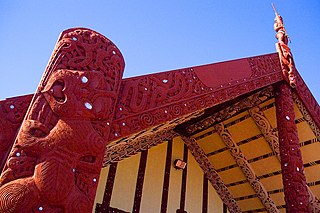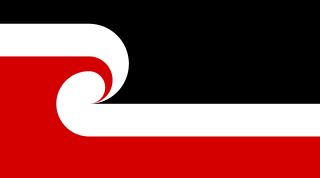
Māori culture involves the customs, cultural practices, and beliefs of the indigenous Māori people of New Zealand. It originated from, and is still part of, Eastern Polynesian culture. Māori culture also forms a distinctive part of New Zealand culture and, due to a large diaspora and the incorporation of Māori motifs into popular culture, is found throughout the world. Within Māoridom, and to a lesser extent throughout New Zealand as a whole, the word Māoritanga is often used as an approximate synonym for Māori culture, the Māori-language suffix -tanga being roughly equivalent to the qualitative noun-ending -ness in English. Māoritanga has also been translated as "[a] Māori way of life."

Tino rangatiratanga is a Māori language term that is often translated as 'self-determination or sovereignty’. It appears in the Māori version of the Treaty of Waitangi, signed by the British Crown and Māori chiefs (rangatira) in 1840. It has become one of the most contentious phrases in retrospective analyses of the Treaty, amid debate surrounding the obligations agreed to by each signatory. The phrase features in current historical and political discourse on race relations in New Zealand, and is widely used by Māori advocacy groups. A flag based on tino rangatiratanga was designed in 1990, and has become accepted as a national flag for Māori groups across New Zealand.

"Kiwi" is the nickname used internationally for people from New Zealand, as well as being a relatively common self-reference. Unlike many demographic labels, its usage is not considered offensive; rather, it is generally viewed as a symbol of pride and endearment for the people of New Zealand. The name derives from the kiwi, a native flightless bird, which is a national symbol of New Zealand. Until the First World War, the kiwi represented the country and not the people; however, by 1917, New Zealanders were also being called "Kiwis", supplanting other nicknames.

The unofficial flag of the Chatham Islands is a blue field with a map of the island in the centre, the Te Whanga Lagoon depicted in white. Behind this device map is a depiction of the rising sun, an allusion to its local name Rekohu, meaning 'rising sun'.

Christchurch Girls' High School in Christchurch, New Zealand, was established in 1877 and is the second oldest girls' secondary school in the country.

Te Ara: The Encyclopedia of New Zealand is an online encyclopedia established in 2001 by the New Zealand Ministry for Culture and Heritage. The web-based content was developed in stages over the next several years; the first sections were published in 2005, and the last in 2014 marking its completion. Te Ara means "the pathway" in the Māori language, and contains over three million words in articles from over 450 authors. Over 30,000 images and video clips are included from thousands of contributors.

The villages and then city that lay at the head of Otago Harbor never existed in isolation, but have always been a staging ground between inland Otago and the wider world. While Dunedin's current official city limits extend north to Waikouaiti, inland to Middlemarch and south to the Taieri River mouth, this articles focus is the history of the Dunedin urban area, only mentioning Mosgiel, the Otago Peninsula, Port Chalmers and inland Otago for context.
Indian New Zealanders or Indo-Kiwis are New Zealanders of Indian origin or descent, living in New Zealand. Although the term "Indian" is more of a nationality, rather than ethnicity given the vast racial diversity within the populations of India, it generally denotes people with subcontinental heritage. The term includes Indians born in New Zealand, immigrants from India, Indian Fijians, Indians born in Africa such as Indian South Africans and Indians in East Africa or any New Zealander with one or both parents of Indian heritage. Although sometimes times the Indo-Kiwi definition has been expanded to people with mixed racial parentage with one Indian parent or grandparent, this can be controversial as it generally tends to remove the ethnic heritage or identity of the foreign parent or grandparent which may be termed as insensitive to those with mixed parentage, who tend to value both their Indian and non-Indian parents and grandparents.

The health care system of New Zealand has undergone significant changes throughout the past several decades. From an essentially fully public system based on the Social Security Act 1938, reforms have introduced market and health insurance elements primarily since the 1980s, creating a mixed public-private system for delivering healthcare.

Waiwhetū is an eastern suburb of Lower Hutt in the Wellington Region situated in the south of the North Island of New Zealand.
The New Zealand Open is a darts tournament organized by the New Zealand Darts Council that has been held annually since 1983.
Beatrice Mary Barth was a New Zealand piano teacher. She was born in London, England.

Matapouri is a coastal settlement in Northland, New Zealand. It is 35 km north-east of Whangarei.
Māori Indians are an ethnic group in New Zealand of people with mixed Māori and Indian ancestry.

Housing in New Zealand is based traditionally on the quarter-acre block, detached suburban home, but many historical exceptions and alternative modern trends exist. New Zealand has largely followed international designs. From the time of organised European colonization in the mid-19th century there has been a general chronological development in the types of homes built in New Zealand, and examples of each generation are still commonly occupied.

Mental health in New Zealand generally follows the trends of mental health in other OECD countries. New Zealand's 'outdoor life style' and high standard of living are balanced by isolation and a self-reliant culture, which discourages asking for help. Historically, people with mental health problems were institutionalised, whereas now the focus is on care in the wider community. The stigma around poor mental health has been lessened in recent years as a result of this change and public education campaigns. However, New Zealand's minorities and youth continue to be over-represented in the negative mental health statistics.
Elizabeth (Bessie) Mary Hocken, was an artist and translator from New Zealand.
Kahupeka was a Maori healer in the 1400s who helped pioneer herbal medicine in New Zealand. She is remembered in oral history as a Tainui explorer who travelled the North Island experimenting with herbal medicines. She is well known for both her travels through-out New Zealand, as well as naming multiple place locations.


















